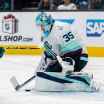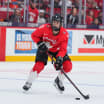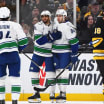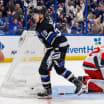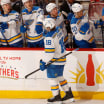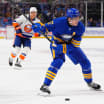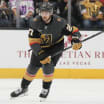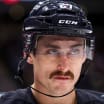ANAHEIM -- There was Paul Kariya, all 5-foot-10 of him, in a land of hockey giants at the 1993 NHL Draft in Quebec City.
Chris Pronger (6-foot-6), Chris Gratton (6-4) and Viktor Kozlov (6-4), all picked in the top six, towered over him. The disparity between Pronger, who was picked No. 2 by the Hartford Whalers, and Kariya, the No. 4 pick by the Mighty Ducks of Anaheim, was especially striking.
Kariya's big offensive numbers belied lack of size
5-foot-10 forward joining giants of hockey with induction into Hall of Fame on Monday
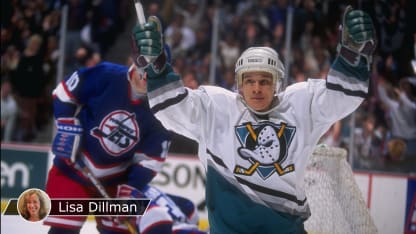
By
Lisa Dillman @reallisa / NHL.com Staff Writer
"I was listed in my draft year at 5-11, 185 (pounds)," Kariya said. "I was, maybe 5-9 1/2, 153."
It was a leap of faith for the expansion Mighty Ducks to go against the grain and take a smaller, skilled player. However, general manager Jack Ferreira was so impressed by what he saw from Kariya playing at the University of Maine, he purposely left a game early hoping to mask his interest in the dynamic forward.
It was one more example of how the Mighty Ducks and Kariya were ahead of the curve.
\[RELATED: Andreychuk proud long NHL career led to Hall of Fame\]
Kariya, who paid close attention to training and nutrition during a time when those elements were often downplayed, not only survived but prospered in the NHL, becoming a three-time First All-Star Team selection, two-time winner of the Lady Byng Trophy (1996, 1997) and finishing his career with 989 points (402 goals, 587 assists) in 989 games with Anaheim, the Colorado Avalanche, Nashville Predators and St. Louis Blues.
Kariya, born in Vancouver, also was a member of the gold-medal winning team for Canada at the 2002 Salt Lake City Olympics.
Kariya will be joining the giants of hockey on Monday when he's inducted into the Hockey Hall of Fame in Toronto, along with Dave Andreychuk, Clare Drake, Danielle Goyette, Jeremy Jacobs, Mark Recchi and Teemu Selanne.
"It was unexpected," Kariya said of being elected to the Hall of Fame. "As a player, I never thought of attaining individual goals and I would never ever think I deserve this honor. That never crossed my mind. It's been an unbelievable experience."
Kariya's size was an issue leading up to the 1993 draft. He and close friend Selanne, a linemate with the Mighty Ducks from 1996-2001, had fun talking about it during a joint interview.
"He was like a little boy," Selanne said.
Kariya played for Canada at the IIHF World Championship in 1993 and remembers meeting coach Mike Keenan before the tournament.
"I had just taken off my shirt, and Keenan came in the [dressing] room to meet me," Kariya said. "I could see him like looking at me and he's thinking, 'He's going to play against professionals?'
"He actually made a comment and said, 'Wayne [Gretzky] had no chest either.'"
These days, the success of smaller players like Johnny Gaudreau (5-9, 157 pounds) of the Calgary Flames and Cam Atkinson (5-8, 179) of the Columbus Blue Jackets is not as startling. Kariya's prime came at a time where size mattered more and getting to the net meant paying the price.
"He was doing all this, at his size, in a day and age where guys were 6-3, 225 pounds and banging and crashing," said Steve Rucchin, who centered Kariya and Selanne in Anaheim.
"You could get away with a lot more stuff back then, in terms of abuse and punishment. How much easier would it be now for him to get to the net? Let's just say the numbers would even higher for him."
Said Ferreira: "When I first saw [Kariya] play, I thought he'd be a 70-assist guy. But he turned out to be a goal-scorer more than a playmaker. He was the finisher."
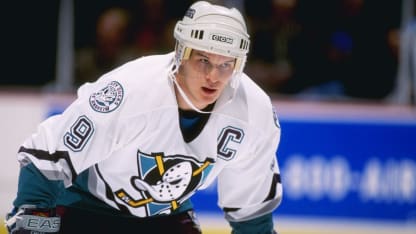
© Glenn Cratty
Ferreira, now a senior adviser for the Los Angeles Kings, was hired by the Mighty Ducks a few months before he drafted Kariya. He and assistant GM Pierre Gauthier had traveled that spring to Worcester, Massachusetts, to watch Kariya play in a NCAA regional game for Maine.
"We went to the game and he played two periods and I said to Pierre, 'Let's get out of here,'" Ferreira said. "I don't what anybody to think I really like him."
As the Ducks' first draft pick, Kariya was looked upon as the face of the franchise. He had 39 points (18 goals, 21 assists) in 47 games as a rookie during the lockout-shortened 1994-95 season.
In the first 59 games the following season, Kariya had 64 points (29 goals, 35 assists). On Feb. 7, 1996, Ferreira would ease the burden on Kariya, pulling off a blockbuster trade that brought Selanne from the Winnipeg Jets.
In the final 29 games of that season, playing with Selanne, Kariya had 44 points (21 goals, 23 assists).
"Forget about on the ice, what I learned from him, as player," Kariya said of Selanne. "But off the ice, he was a balancing act. I was way too serious … in general too serious. He was a really good influence, more so off the ice than on the ice."
Friends and relatives are often amused by the way Kariya and Selanne know exactly what the other is thinking.
Kariya recently was giving a thoughtful answer about the pros and cons of taking a front-office position in the NHL. Selanne knew exactly where he was heading with the answer and got there before Kariya, an avid surfer, did.
"Knowing him, there wouldn't be time for anything else," Selanne said.
"That's 100 percent, good point," Kariya said. "If I was going to do something, it would have to be 100 percent. There's a big swell coming in and I'm going, 'Oh my God.'"
Kings general manager Rob Blake, who has tried to gauge Kariya's interest in a front-office job, is also a surfer and gets his passion for the water. He understands how Kariya goes all in once he makes up his mind or gets interested in something.
"We all surf, but none of us knows anything about our boards," Blake said. "We just get a board and use it. He knows the fins, the thickness and the weight of the boards. It's just like he was with hockey."
Kariya had two 100-point seasons and one 50-goal season. Considering that he played in a more restrictive era, Blake pondered how good Kariya would be if he played now.
"There was a time where he was as good as they come in the NHL," Blake said. "You couldn't check him then. You can't check him now."
Being elected to the Hall of Fame has afforded Kariya the time to reflect on his career and the people around him. Family members of his late agent, Don Baizley, will be in Toronto. So will Rucchin.
"That's the least I can do for what I put him through," Kariya said of his former center. "I took five years off his career. He would be so tired after shifts."
Rucchin didn't argue. He can hold his own with his former linemates in terms of sarcastic wit.
"I would have gladly taken some back-door [goals], tap-ins," Rucchin said. "Let's just say they're not going to the Selke Award Hall of Fame."
Kariya's final game with the Mighty Ducks was Game 7 of the 2003 Stanley Cup Final, a 3-0 loss to the New Jersey Devils. Rucchin was a teammate but Selanne was gone, having been traded to the San Jose Sharks on March 5, 2001.
Kariya and Selanne reunited with the Avalanche for the 2003-04 season in the hope of making a serious Cup run. Colorado also had Hall of Famers Joe Sakic, Peter Forsberg and Blake, but the Avalanche struggled with injuries.
"I think we were in the lineup, all of us together, for one game," Blake said. "We played Chicago and beat them 5-0 opening night. But Paul hurt his wrist and Teemu hurt his knee and we were never had everybody back together.

© Brian Bahr/Getty Images
"He really enjoyed just being one of the guys," he said of Kariya. "I'm sure in Anaheim when people walked in, they were scared to talk to him. When he got to Colorado, a good team, he was just in the group."
Kariya then played two seasons with the Predators and finished his career with the Blues. The closest he came to winning the Stanley Cup was the 2003 run with the Mighty Ducks.
In that Final, he took a thunderous hit from Devils defenseman Scott Stevens in Game 6 that knocked him out. He returned to score the game-winning goal, then played in Game 7.
It was one of several hard hits Kariya took during his career. His final season was 2009-10; he took the following season off to recover from concussion symptoms, then retired at age 36.
"With most things, with time and perspective, now it's seven years since I retired -- if I'm looking back on my career, I never look back at any of those hits," said Kariya, who turned 43 on Oct. 16. "… That's totally out of my mind. If I'm looking back on my career, I look back at those great memories I had playing."
He said his experience was no different than people having ups and downs in any sport or any career.
"If I had a magic wand and could wave the wand and go through the exact same thing, the good and the bad -- If I had the opportunity to do it again, I would do it in a heartbeat."


